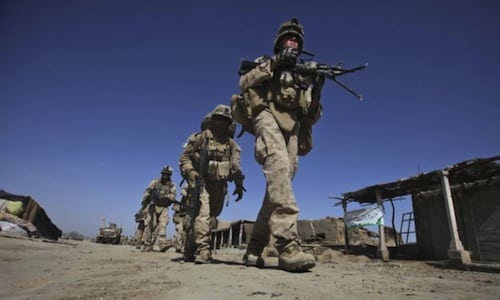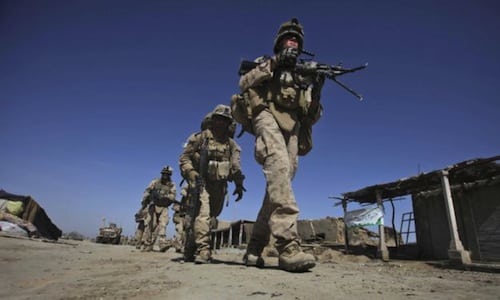Speaking at the UN General Assembly on Sept. 29, Syria’s Foreign Minister Walid al-Moualem demanded that US, French and Turkish forces leave his country immediately or be dealt with “accordingly”. Indeed, with the Islamic State reduced to insignificance, they have no justification for being there. The message is primarily addressed to Washington. Trained and equipped by the United States, the Syrian Democratic Forces (SDF) control roughly 25-30 percent of Syria, including areas which hold the bulk of the country’s oil and gas reserves. The group has pressed for Syria’s division along federal lines with autonomous cantons created in various regions. It has already set up cantonal administrations in areas it controls with their own revenues, police and public services.
The SDF is backed by 2,200 US troops on the ground illegally operating in a foreign country. The forward operating base at Al Tanf is manned by American military. It is located at the strategic border area between Iraq, Syria and Jordan. Last month, the Marine Corps conducted an exercise to demonstrate that the United States is there for the long haul.
Presidential candidate Trump promised to stay out of foreign wars. In April, the US president said the forces would leave Syria soon with the decision taken “very quickly” on how long they will remain there. “We’ll be coming out of Syria, like, very soon. Let the other people take care of it now,” he stated. On Sept.24, US National Security Adviser (NSA) John Bolton said the US would remain in Syria “until Iran leaves”. “We’re not going to leave as long as Iranian troops are outside Iranian borders, and that includes Iranian proxies and militias,” the NSA formulated the US position. According to Military Times, his statement was “signaling a fundamental shift from the current counter-terrorism operations to a mission focused more on geopolitical maneuvering and proxy warfare.”The source believes the White House has revealed a massive mission creep. It cited James Phillips, senior research fellow for Middle Eastern affairs at the Heritage Foundation, who said. “I would prefer to keep US troops there indefinitely, because they also serve a purpose in blocking Iran’s freedom of movement and access to lines of communication that would connect western Iraq with Lebanon.”
Earlier last month, the secretary of state’s Special Representative for Syria engagement James Jeffrey said that the US military could pursue an enduring presence in part to complicate Iranian activities in the country. According to him, the forces will remain beyond “the end of the year”.
Looks like they will stay much longer. Special Representative for Syria Engagement, Ambassador James Jeffrey, openly intervened into Syria’s internal affairs by threatening it with sanctions the US would impose if it Syria did not align its domestic laws with Washington’s instructions. According to him, the US would work with countries in Europe, Asia and the Middle East to impose tough international sanctions in circumvention of the UN Security Council if Syria’s government failed to cooperate on rewriting the country’s constitution as a prelude to elections. “We will make it our business to make life as miserable as possible for that flopping cadaver of a regime and let the Russians and Iranians, who made this mess, get out of it,” he warned.
It has been recently reported that the United States has set up a new military base near the Iraqi town of Al-Qa’im in Anbar province on the Iraqi-Syrian border. It is located near the strategic border crossing that links to the Syrian town of Abu Kamal. The US air defense and electronic radar systems in Kobani, the Aleppo governorate in northern Syria, and on the territory of the al-Shaddadi base in the Hasakah province. A no-fly zone could be established in northern Syria stretching from Manbij to Deir ez-Zor. The US will stay to prevent Iran from gaining access to the Mediterranean Sea.
US intelligence officials have already prepared a preliminary list of targets in Syria to strike upon the president’s order. A staged chemical attack in Idlib that Russia has warned about will serve as a pretext. The efforts to find a peaceful solution have intensified with the Russian-Turkish agreement on Idlib coming into force but the process does not include the United States.
The Trump administration is pressing ahead with plans to create an Arab NATO, tentatively dubbed the “Middle East Strategic Alliance,” or MESA, to confront Iran everywhere in the region. Secretary of State Mike Pompeo met in New York on Sept.28 with foreign ministers from Bahrain, Egypt, Jordan, Kuwait, Oman, Qatar, Saudi Arabia and the United Arab Emirates to advance the project. Washington is preparing to host a summit in January to launch the alliance.
A collective defense clause is likely to be included in the list of the common commitments. Meanwhile, the work to expand Al-Udeid airbase in Qatar is going on to prepare for military operations. Talks are underway to make it a “permanent base”.
Evidently, Washington has made a decision to stay in Syria for a long time. It needs an alliance to support it militarily and diplomatically. Using the Iran threat” bogey to lead the MESA will restore the US image as an indispensable nation in the Middle East after unimpressive operations in Iraq, Syria, Afghanistan as well as other countries America has intervened into on a much smaller scale in recent years. The Astana process led by Russia, Turkey and Iran opens promising prospects for a peaceful solution of Syria’s conflict. Another scenario is Syria turning into a battlefield between US-led and Israel-supported MESA and Iran. It will certainly spill over to encompass Iraq, Yemen and Lebanon. The bigger is the fire of war the more “indispensable” will the US become, reaping all the benefits of being the leader of the anti-Iran coalition.
Reprinted with permission from Strategic Culture Foundation.


